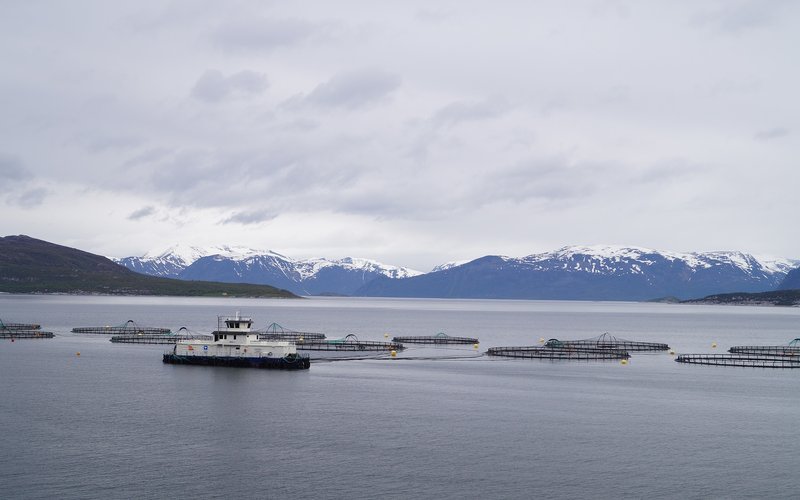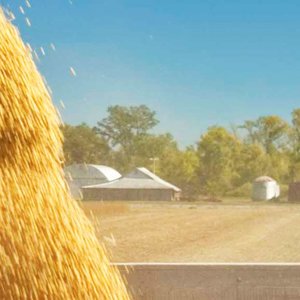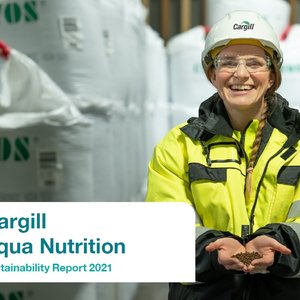Funded by the Norwegian Seafood Research Fund, the study by Norwegian researchers was developed using 2020 data from four aquafeed companies – BioMar, Cargill, Mowi and Skretting – and public data on the amount of salmon and trout produced. The team also collected fish for chemical analysis. It follows previous studies on Atlantic salmon for 2010, 2012 and 2016.
Reported in two separate publications, the research shows the utilization of feed resources for rainbow trout (Oncorhynchus mykiss) and Atlantic salmon (Salmo salar) farming together with an overview of the retention of nutrients in fillets and whole fish.
No great differences between salmon and trout farming in terms of utilization of feed resources have been found, aside from some minor differences in the utilization of feed resources due to species-specific physiology and body composition.
Regarding salmon farming, apart from an increase in the amount produced and a small increase in eFCR, the study shows that there were minor changes in the utilization of feed resources in 2020 compared to 2016. Moreover, feeds for the two species are in practice formulated identically.
Researchers highlighted that an undefined amount of salmon feed is used for trout production causing inaccuracy in the data for trout farming since the amount of this could not be quantified.
Feed resources and retention of nutrients in salmon
Approximately 2 million tonnes of feed ingredients were used to obtain almost 1.5 million tonnes of manufactured feeds for Atlantic salmon. Aquafeeds were produced from vegetable ingredients (73%), marine ingredients (22%), and micro ingredients (4%), such as vitamin and mineral premixes, astaxanthin, and crystalline amino acids (Fig. 1). In addition, approximately 8,100 tonnes (0.4%) of feed ingredients were made up of single-cell protein, insect meal, fermented products, and microalgae. Soy protein concentrate was the ingredient used in the largest amount (20.9% of the feed ingredients) as it was in 2016. Rapeseed oil represented 18.0% of the ingredients.
More in deep, Norwegian marine protein and oil constituted only 8% of the ingredients while the remaining 92% of the marine ingredients were imported. Brazil was the main supplier of vegetable protein sources (368,497 tonnes). A substantial amount (255,330 tonnes) of vegetable protein sources was also produced in Europe. Vegetable oils were mainly produced in Europe and Russia.
The feed conversion factor was 1.35 if calculated from feed ingredients as is, or 1.25 if calculated from ingredients on a dry matter basis. Additionally, the retention of energy, dry matter, protein, fat, EPA & DHA, and phosphorus from feed was 39%, 33%, 34%, 57%, 49%, and 25%, respectively, considering the whole salmon. On the other hand, in fillet, the corresponding retention rates were 25%, 21%, 25%, 35%, 32% and 12 %, respectively.
Finally, the feed ingredients used and the utilization of feed in 2020 resembled that of 2016, except that there was an increase in the amount produced in 2020 and a slight increase in the economic feed conversion ratio (eFCR).

Figure 1. Sources of feed ingredients (% of feed) in Norwegian trout feed in 2020 (right), compared to data for salmon feed from 1990 to 2020 (from Aas et al., 2022) .
Feed resources and retention of nutrients in rainbow trout
The rainbow trout study is the first of its kind and shows that almost 90,000 tonnes were produced (6% of the amount of salmon) using 117,000 tonnes of ingredients.
Trout’s feed was produced from vegetable protein sources (40%), vegetable oils (20%), marine protein sources (13%), carbohydrate sources (12%), marine oils (11%), and micro ingredients (4%) (Fig. 1). Apart from micro ingredients, which include vitamin and mineral premixes, crystalline amino acids, and astaxanthin, 257 tonnes (0.2%) of single-cell protein, insect meal, fermented products, and microalgae were also used in trout feed. Similarly, as reported in salmon, national fishmeal and fish oil constituted 9% of the ingredients while the remaining 91% was imported.
Economic feed conversion factor (eFCR) was 1.30, 1.21 or 1.44 if calculated from feed ingredients as is, feed ingredients on dry matter basis, or from registered traded feed, respectively. Furthermore, nutrient retention in the whole body, being 37%, 43%, 33%, 63%, and 63% for dry matter, energy, protein, fat, and EPA & DHA. Regarding the fillet, the corresponding retention values were 21%, 25%, 23%, 34%, and 35%, respectively.
The study also highlights how trout feeds have changed in the past few years. Historically, trout feed has had a different development than salmon feed. High inclusion of vegetables was used early for trout. In 1985, a standard trout feed was produced from 30% fishmeal, 30% soybean meal, 26% carbohydrate sources, 11% fish oil and 3% micro ingredients by cold pelleting. At the same time, salmon feed contained no soybean meal, and was produced mainly from marine ingredients by extrusion. After this, there was a shift in feeds used for trout, which became more similar to salmon feeds.
References
Aas T. S., Åsgård T., Ytrestøyl T. (2022). Utilization of feed resources in the production of Atlantic salmon (Salmo salar) in Norway: An update for 2020. Aquaculture Reports, 26, 101316. https://doi.org/10.1016/j.aqrep.2022.101316
Aas T. S., Åsgård T., Ytrestøyl T. (2022). Utilization of feed resources in the production of rainbow trout (Oncorhynchus mykiss) in Norway in 2020. Aquaculture Reports, 26, 101317. https://doi.org/10.1016/j.aqrep.2022.101317










